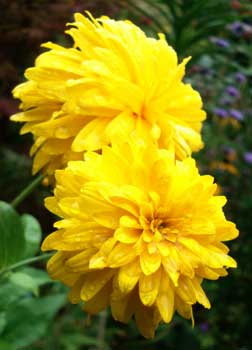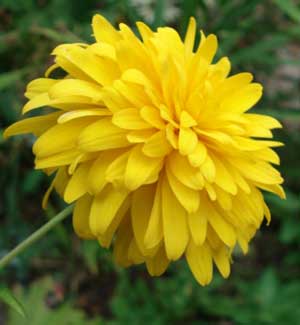
Rudbeckia x 'Goldquelle'
Golden Fountain Cutleaf Coneflower
aka, Gold Drops
"The sunlight on the garden
Hardens & grows cold,
We cannot cage the minute
Within its nets of gold;
When all is told
We cannot beg for pardon."
-Louis MacNeice
(1907-1963)
The hybrid 'Goldquelle' Gold Drops or Golden Fountain Cutleaf Coneflower, is a recipient of the Royal Horticultural Society's Award of Garden Merit for beauty & reliable garden performance. It is similar to an older cultivar called 'Golden Glow,' but not as spreading & much more compact.(1907-1963)
 Out of the highly compact basal foliage from there arises three-inch large round fully double yellow pompoms to three-feet of height beginning mid-summer. By deadheading spent blossoms, flowers will persist through the entirety of autumn, beyond first frost.
Out of the highly compact basal foliage from there arises three-inch large round fully double yellow pompoms to three-feet of height beginning mid-summer. By deadheading spent blossoms, flowers will persist through the entirety of autumn, beyond first frost.Our clump by right of getting some shade from the nearby 'Oshio Beni' Japanese maple doesn't bloom until late summer, but it persists until November. The first photo up top was snapped in November, the second photo in September. Our easy climate on Puget Sound barely permits it to notice summer is long over.
It prefers full sun but won't do badly in bright shade, though more apt to require staking in even a little shade. Average moist well-drained soil is best, but once well established, it becomes drought hardy. Too rich a soil will increase foliage rather than bloom, & perhaps increase the necessitiy of staking.
'Goldquelle' is a hybrid of Rudbeckia lacinata var hortensia which is the naturally occurring double form of Cutleaf Coneflower native to New England, pollinated by its smaller southern cousin R. nitida or Shiny Coneflower which is a more normal looking black-eyed-susan with cone. The fully double hybrid is shorter & much more densely leafed than either of its parent species. Plus it has no actual cone, rendering "coneflower" a misnomer, hence its alternate name Gold Drops.
Poor drainage can cause it to rot out in the winter, though it tolerates considerable moisture the rest of the year. It's extremely cold-hardy so barring sogginess, it will always return a happy camper when winter ends, whether in Zone 3 or Zone 8 -- & it's seasonal cold/heat tolerances can be potentially stretch to zones 2 through 9.
It develops a thick & extensive root system & the clump can spread fairly rapidly, though not half as rapidly as wild R. laciniata which can be invasive. Very drought tolerant once its extensive roots is well established, it will need moderate watering its first year & less thereafter, becoming a good choice for the xeriscape sungarden, as well as the cutting garden, the butterfly garden, or any bed of mixed perennials.
Continue to:
Rudbeckia laciniata cutleaf coneflower